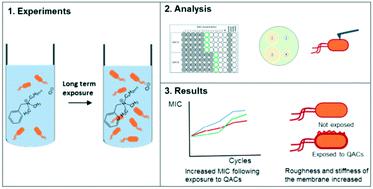当前位置:
X-MOL 学术
›
Environ. Sci.: Water Res. Technol.
›
论文详情
Our official English website, www.x-mol.net, welcomes your
feedback! (Note: you will need to create a separate account there.)
Adaptation of Pseudomonas aeruginosa to constant sub-inhibitory concentrations of quaternary ammonium compounds
Environmental Science: Water Research & Technology ( IF 3.5 ) Pub Date : 2020-02-17 , DOI: 10.1039/c9ew01056d Margaux Voumard 1, 2, 3, 4, 5 , Leonardo Venturelli 4, 5, 6, 7, 8 , Myriam Borgatta 5, 9, 10, 11 , Antony Croxatto 5, 12, 13 , Sandor Kasas 4, 5, 6, 7, 8 , Giovanni Dietler 4, 5, 6, 7, 8 , Florian Breider 2, 3, 4, 5, 14 , Urs von Gunten 1, 2, 3, 4, 5
Environmental Science: Water Research & Technology ( IF 3.5 ) Pub Date : 2020-02-17 , DOI: 10.1039/c9ew01056d Margaux Voumard 1, 2, 3, 4, 5 , Leonardo Venturelli 4, 5, 6, 7, 8 , Myriam Borgatta 5, 9, 10, 11 , Antony Croxatto 5, 12, 13 , Sandor Kasas 4, 5, 6, 7, 8 , Giovanni Dietler 4, 5, 6, 7, 8 , Florian Breider 2, 3, 4, 5, 14 , Urs von Gunten 1, 2, 3, 4, 5
Affiliation

|
Quaternary ammonium compounds (QACs) are widely used in consumer products for disinfection purposes. QACs are frequently detected in aquatic systems at sub-inhibitory concentrations and were found to affect the development of antimicrobial resistance if bacteria are exposed to increasing concentrations. However, the effect of a constant sub-inhibitory concentration on the development of bacterial resistance is unknown. A constant exposure to 88% of the minimum inhibitory concentration (MIC) of benzalkonium chloride (BAC) led to an increase of the MIC of P. aeruginosa. It increased from 80 mg l−1 to 150 mg l−1 after 10 cycles of exposure and remained stable after removal of BAC. When exposed to cetyltrimethyl ammonium chloride (CTMA), P. aeruginosa's MIC increased from 110 mg l−1 to 160 mg l−1 after 10 cycles of exposure and decreased to 120 mg l−1 after removal of CTMA. Additionally, cross-resistance between the QACs was observed. When exposed to BAC, the MIC for CTMA increased from 110 mg l−1 to 200 mg l−1, and when exposed to CTMA, the MIC for BAC increased from 80 mg l−1 to 160 mg l−1. In contrast, the susceptibility to 16 antibiotics was not significantly affected by exposure to QACs. Finally, analyses of the membranes' nanomechanical properties of P. aeruginosa with atomic force microscopy (AFM) showed increases in cell roughness, adhesion and stiffness after treatment with CTMA. Since sub-inhibitory concentrations of QACs can be detected in (technical) aquatic systems including sediments, this may lead to a dissemination of bacteria with higher QAC resistance in the environment.
中文翻译:

铜绿假单胞菌对恒定的亚抑菌浓度季铵化合物的适应性
季铵化合物(QAC)广泛用于消费类产品的消毒目的。在水生系统中经常以亚抑制浓度检测到QAC,如果细菌暴露于浓度不断增加的情况下,QAC会影响抗菌素耐药性的发展。但是,恒定的亚抑菌浓度对细菌耐药性发展的影响尚不清楚。持续暴露于苯扎氯铵最低抑制浓度(MIC)的88%导致铜绿假单胞菌的MIC升高。暴露10次后,它从80 mg l -1增加到150 mg l -1,并在去除BAC后保持稳定。当暴露于十六烷基三甲基氯化铵(CTMA)时,暴露10个周期后,铜绿假单胞菌的MIC从110 mg l -1增加到160 mg l -1,而在去除CTMA后降低到120 mg l -1。此外,观察到QAC之间的交叉电阻。当暴露于BAC时,CTMA的MIC从110 mg l -1增加到200 mg l -1,当暴露于CTMA时,BAC的MIC从80 mg l -1增加到160 mg l -1。相反,暴露于QAC对16种抗生素的敏感性没有显着影响。最后,对铜绿假单胞菌的膜的纳米力学性能进行了分析。原子力显微镜(AFM)观察到,CTMA处理后细胞粗糙度,粘附力和硬度增加。由于可以在(技术)水生系统(包括沉积物)中检测到QAC的亚抑制浓度,因此这可能导致环境中QAC耐药性较高的细菌传播。
更新日期:2020-02-17
中文翻译:

铜绿假单胞菌对恒定的亚抑菌浓度季铵化合物的适应性
季铵化合物(QAC)广泛用于消费类产品的消毒目的。在水生系统中经常以亚抑制浓度检测到QAC,如果细菌暴露于浓度不断增加的情况下,QAC会影响抗菌素耐药性的发展。但是,恒定的亚抑菌浓度对细菌耐药性发展的影响尚不清楚。持续暴露于苯扎氯铵最低抑制浓度(MIC)的88%导致铜绿假单胞菌的MIC升高。暴露10次后,它从80 mg l -1增加到150 mg l -1,并在去除BAC后保持稳定。当暴露于十六烷基三甲基氯化铵(CTMA)时,暴露10个周期后,铜绿假单胞菌的MIC从110 mg l -1增加到160 mg l -1,而在去除CTMA后降低到120 mg l -1。此外,观察到QAC之间的交叉电阻。当暴露于BAC时,CTMA的MIC从110 mg l -1增加到200 mg l -1,当暴露于CTMA时,BAC的MIC从80 mg l -1增加到160 mg l -1。相反,暴露于QAC对16种抗生素的敏感性没有显着影响。最后,对铜绿假单胞菌的膜的纳米力学性能进行了分析。原子力显微镜(AFM)观察到,CTMA处理后细胞粗糙度,粘附力和硬度增加。由于可以在(技术)水生系统(包括沉积物)中检测到QAC的亚抑制浓度,因此这可能导致环境中QAC耐药性较高的细菌传播。











































 京公网安备 11010802027423号
京公网安备 11010802027423号